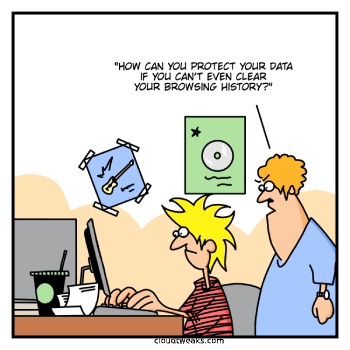Threat hunting is a proactive cybersecurity process where specialists, known as threat hunters, search through networks and datasets to identify threats that existing automated security solutions may have missed. It’s about thinking like the attacker, anticipating their moves and countering them before they can cause harm.
Threat hunting is an essential tool in our cybersecurity toolbox, especially in an era where threats are becoming increasingly sophisticated and stealthy. Threat hunting allows us to stay one step ahead of the attackers, identifying and mitigating threats before they can cause significant damage.
However, mastering threat hunting is no small feat. It requires a deep understanding of different types of threats, as well as a systematic approach to hunting them down. This brings us to the next section, where we’ll discuss the types of threats that you can expect in the public cloud.
Malware and ransomware are among the most common threats in the public cloud. Malware, short for malicious software, includes any software designed to cause harm to a computer, server, client, or computer network. Ransomware, a type of malware, locks users out of their data until a ransom is paid. These threats are becoming increasingly sophisticated, with new variants appearing all the time.
To counter these threats, we need to understand their behaviors and indicators of compromise. This allows us to identify them promptly and take appropriate action.
Data exfiltration, also known as data theft, involves unauthorized transfer of data from a computer. In the context of the public cloud, data exfiltration can be particularly damaging as vast amounts of sensitive data are often stored in the cloud. Threat actors may employ various techniques to exfiltrate data, such as command and control servers, data staging, or even covert channels.
By understanding the ways in which data can be exfiltrated, and by continuously monitoring for signs of such activity, threat hunters can identify and stop data exfiltration attempts in their tracks.
Identity and credential threats involve the unauthorized use of identities or credentials to gain access to systems and data. In the public cloud, where access is often controlled through identity and access management (IAM) systems, these threats can be particularly potent.
Threat hunting in this context involves keeping an eye out for unusual activity that may indicate unauthorized use of identities or credentials. This could include unexpected location or time of access, unusual patterns of behavior, or attempts to escalate privileges.
Misconfigurations and vulnerabilities represent another significant threat in the public cloud. Misconfigurations can expose data or systems to unauthorized access, while vulnerabilities can be exploited to gain access or escalate privileges.
Threat hunting involves identifying these misconfigurations and vulnerabilities before they can be exploited. This requires a comprehensive understanding of system configurations and potential vulnerabilities, as well as continuous monitoring for changes that could introduce new risks.
Now that we’ve discussed the types of threats that you can expect in the public cloud, let’s review the general process of threat hunting.
The first step is defining the scope of your threat hunting. This involves identifying the boundaries of your search, including the systems, networks, and data that you will examine. As a rule of thumb, the broader the scope, the more comprehensive your threat hunting will be.
However, defining scope isn’t just about breadth. It’s also about depth. You need to determine how far back in time you will look for threats and how deeply you will delve into each potential incident. In my experience, a balance between breadth and depth is essential for effective threat hunting.
Lastly, defining the scope includes setting your objectives. What are you trying to achieve with your threat hunting? Are you looking for specific threats or are you conducting a general sweep? By clearly defining your objectives, you can ensure that your threat hunting is focused and productive.
Once you’ve defined your scope, the next step is to identify potential indicators of compromise (IoCs). These are signs that a system or network may have been breached. In the context of the public cloud, IoCs could include unusual network traffic patterns, unexpected changes in system configurations, or suspicious user activity.
Identifying IoCs is a critical part of threat hunting. It requires a deep understanding of the typical behavior of your systems and networks, as well as the ability to recognize anomalies.

After identifying potential IoCs, the next step is data collection. This involves gathering all relevant data that could help you investigate the IoCs. In the public cloud, this could include log data, network traffic data, system configuration data, and user activity data.
Data collection is a meticulous process. It requires careful planning and execution to ensure that all relevant data is collected and nothing is missed. It also requires a deep understanding of the data sources in your cloud environment and how to extract data from them.
With your data in hand, the next step is data analysis and querying. This involves examining the collected data to uncover evidence of a compromise.
Data analysis requires a deep understanding of the data you’re working with and the ability to interpret it correctly. It also requires the ability to ask the right questions—or queries—of your data. For example, you might query your data for signs of unusual network traffic or suspicious user activity.
Once you’ve analyzed your data, the next step is correlation and enrichment. This involves comparing and combining your findings to create a more complete picture of the potential compromise.
Correlation involves linking related pieces of evidence. For example, you might correlate an unusual network traffic pattern with a suspicious system configuration change. By doing this, you can gain a better understanding of the nature and extent of the potential compromise.
Enrichment, on the other hand, involves adding context to your findings. You might enrich your data with information from external threat intelligence sources or with historical data from your own systems. This can give you a deeper understanding of the potential threat and help you make more informed decisions about how to respond.
After correlating and enriching your data, the next step is investigation and validation. This involves delving deeper into the potential compromise to confirm its existence and understand its impact. If validated, you can then proceed to the next step of containment and eradication.
Investigation may involve a variety of techniques, from further data analysis to hands-on system and network examination. Throughout this process, it’s essential to maintain a methodical approach to ensure that no stone is left unturned.
Validation, on the other hand, involves confirming that the identified threat is real. This might involve replicating the suspected behavior or comparing your findings with known threat indicators. If the threat is validated, it’s time to take action.
Once a threat has been validated, the next step is containment and eradication. This involves taking steps to limit the impact of the threat and remove it from your systems and networks. In the public cloud, this might involve isolating affected systems, blocking malicious network traffic, or disabling compromised user accounts.
Containment and eradication is a delicate process. It requires careful planning and execution to ensure that the threat is effectively neutralized without causing unnecessary disruption to your operations.
The final step in the threat hunting process is recovery and documentation. Recovery involves restoring your systems and networks to their normal state. This might involve repairing damaged systems, restoring lost data, or implementing new security measures to prevent future compromises.
Documentation, on the other hand, involves recording all details of the threat hunting process. This includes documenting your findings, actions taken, and lessons learned. Documentation is invaluable for improving future threat hunting efforts and for demonstrating compliance with security regulations.
Threat hunting is a complex and ongoing process. However, by following these steps and continuously refining our methods, we can master the art of threat hunting and ensure the security of our public cloud environments. Remember, the key to successful threat hunting is to always stay vigilant and proactive, and to never stop learning and adapting.
By Gilad David Maayan





